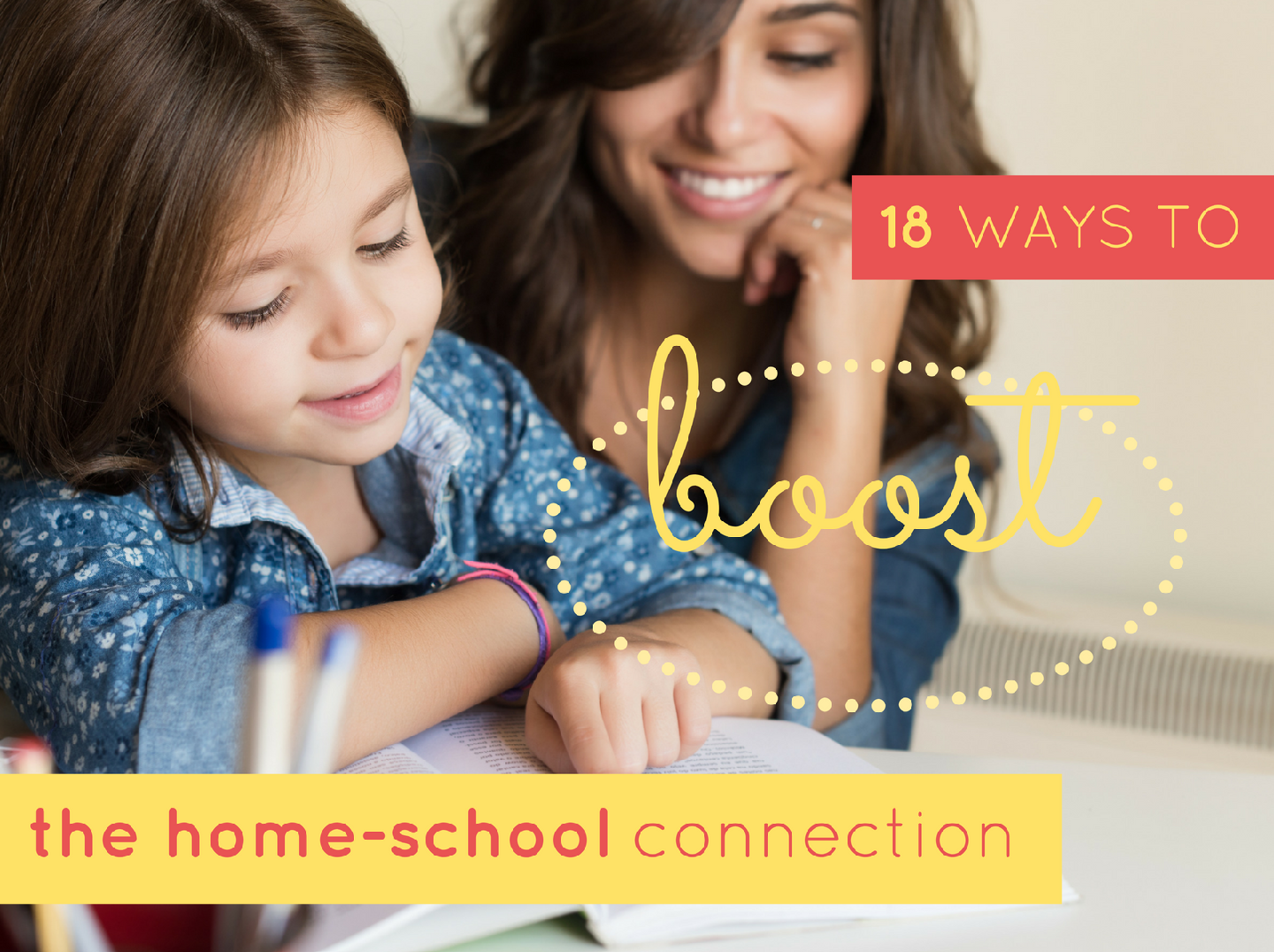18 Ways to Connect and Communicate with Families
November 8, 2016
Nurturing the home-school connection is key to the success of any classroom, but especially important in classrooms that include students with and without disabilities. Partnering with parents will give you unique insights into your students’ gifts, strengths, and needs—and help you create workable solutions to a student’s learning challenges.
Today’s post gives you 18 great suggestions (adapted from Brookes books by top education experts) on how to create and maintain strong partnerships with your students’ families.
1. Send a back-to-school letter.
 Before the beginning of the school year, send home a friendly letter to parents. Begin with a positive statement that conveys excitement about the year ahead, introduce your class expectations, relate any important information parents need to know (the date of Back-to-School Night, what information will be posted online and when), and provide your contact information (be sure to specify when they can call you). If you co-teach, the letter should be from both teachers and include contact information for both of you.
Before the beginning of the school year, send home a friendly letter to parents. Begin with a positive statement that conveys excitement about the year ahead, introduce your class expectations, relate any important information parents need to know (the date of Back-to-School Night, what information will be posted online and when), and provide your contact information (be sure to specify when they can call you). If you co-teach, the letter should be from both teachers and include contact information for both of you.
2. Ask for their preferences.
Before choosing a home-school communication option, check with parents and specifically ask them how they’d prefer to communicate. Some parents will prefer written communication, while others will opt to talk face to face or over the phone. Also, discuss how frequently parents would like to communicate with you or other school team members, and decide on a rough schedule that’s manageable and feasible for everyone.
3. Determine their priorities.
Ask parents at the beginning of the year what their highest priorities are for their child. For some families, it may be helping the child improve in a specific academic area; for others, it may be supporting positive behavior or development of friendships. Assessing parents’ priorities and communicating these priorities to all team members are key to the home-school partnership.
4. Keep a communication notebook.
Notebooks that go back and forth between home and school are a popular home-school communication option. They’re a simple, reliable way to keep parents informed about what’s going on at school and provide educators with the invaluable parent perspective. To make the most of this option, be sure that entries are all signed or initialed by both the teacher and parent, and keep the book in a consistent, convenient place, like the student’s backpack or a pouch on the back of the student’s wheelchair.
5. Go higher-tech.
 Electronic communication can sometimes have advantages over low-tech options like notebooks; for example, you can easily supplement your notes with photos and video, and electronic platforms are available to both teachers and parents at any time. Consider free and low-cost options like journaling apps and blogs, which can be easily adapted for use as a communication book. Or stay in touch through email or text messaging, if the parent is more comfortable with those options. (You might even consider a hybrid approach—use a simple communication notebook but supplement some entries with emailed photos or video.)
Electronic communication can sometimes have advantages over low-tech options like notebooks; for example, you can easily supplement your notes with photos and video, and electronic platforms are available to both teachers and parents at any time. Consider free and low-cost options like journaling apps and blogs, which can be easily adapted for use as a communication book. Or stay in touch through email or text messaging, if the parent is more comfortable with those options. (You might even consider a hybrid approach—use a simple communication notebook but supplement some entries with emailed photos or video.)
6. Phone home.
Try setting aside 15 to 20 minutes each week or every other week to call parents for a friendly update. It’s amazing how much you can accomplish in that small, manageable amount of time. Not only do personal calls to parents build bridges between school and home and foster trust, they also give you a chance to talk through concerns and brainstorm solutions.
7. Be the bearer of good news.
When you’re trying to juggle a hectic schedule, it can be tempting to communicate with parents only when a child’s had a challenge or a difficult day. Be sure to use your communication platforms to share good news, too, so parents can celebrate their child’s accomplishments and positive actions. Every now and then, send an email or text or make a quick phone call to update parents on their child’s achievements and share which ideas and strategies have been working well.
8. Make a house call.
If parents are comfortable with home visits, you might want to try setting one up. A trip to a student’s home can be a great way to get to know families and set up a partnership with them in an environment where they’re comfortable. And seeing your students in their own homes can give you invaluable insights into their social-emotional development and preferred communication styles. (If you can’t visit homes, another option is to spend some time in the communities where your students live and get a feel for their everyday environment.)
9. Use student learning logs.
 For students who can write or type, a daily learning log is a good way to keep parents informed about what’s happening in school. Students can take a few minutes each day to update the log and reflect on the day’s activities and lessons. This provides an excellent opportunity for the student to actively participate in home-school communication (and it’s an extra chance to practice literacy and communication skills). For students who don’t communicate via the written word, a classmate might provide support with this task (by taking dictation, for example).
For students who can write or type, a daily learning log is a good way to keep parents informed about what’s happening in school. Students can take a few minutes each day to update the log and reflect on the day’s activities and lessons. This provides an excellent opportunity for the student to actively participate in home-school communication (and it’s an extra chance to practice literacy and communication skills). For students who don’t communicate via the written word, a classmate might provide support with this task (by taking dictation, for example).
10. Share solution-building.
Solutions to a family’s concerns should be discussed collaboratively by the parents and the teacher, and possibly a few other members of the educational team. After you come up with several workable solutions, review them with parents and ask which one they’re most comfortable with. Encourage the parents to choose which option to try, so they leave feeling empowered with a clear plan of action.
11. Offer language choices for diverse families.
When working with families who are culturally diverse, offer them a choice of language for communication, both at school and between home. If your school doesn’t have easy access to translators, consider recruiting a local university student to translate in his or her area of study or native language, having a parent or relative fluent in English translate for a parent who is not fluent, and using pictures, graphs, and organizational charts to aid your communication.
12. Jettison the jargon.
During a team meeting, do you ever hear statements like these? “He’s currently in a 12-1-1 and could move to consult if the one-to-one follows along. Could the O.T. do push-in in that setting? His fine motor skills need a lot of work.” Jargon might come easily to education professionals, but it can create a barrier for parents and cause confusion and frustration during meetings with them. Minimize use of jargon during sit-downs with parents, and use clear and direct language that puts them at ease and welcomes their participation.
13. Show families you value their child.
 The way you talk about students has a big impact on the success of your partnership with families. Parents want to know that you see their child’s best qualities, so be sure to communicate your optimism about the child and praise his or her positive traits. For example, pointing out a child’s great sense of humor or helpful nature lets parents know that you see and care about their child as a person, and that can go a long way toward gaining the parent’s respect and trust.
The way you talk about students has a big impact on the success of your partnership with families. Parents want to know that you see their child’s best qualities, so be sure to communicate your optimism about the child and praise his or her positive traits. For example, pointing out a child’s great sense of humor or helpful nature lets parents know that you see and care about their child as a person, and that can go a long way toward gaining the parent’s respect and trust.
14. Make parents part of the classroom community.
Invite parents into the classroom for special activities so they can take part in your community. You might invite them to whole-class debates, classroom performances, presentations, or art gallery walks.
15. Be there for after-school events.
Support your students’ communities, too! Attend a community event or activity that the family is involved in, such as a craft fair, a charity walk, a play, or pageant. This communicates support and shows families that your interest doesn’t stop when the dismissal bell rings.
16. Encourage volunteers.
Welcome parents as volunteers and suggest classroom jobs for them that suit their personalities and talents. One parent might enjoy reading to the class or teaching students about a particular area of expertise, while another parent might prefer to prep materials for an activity or type up the class newsletter.
17. Start a game night.
 Lead some activities outside of school to strengthen the home-school connection and get families up to speed with what you’re working on. One fun idea is a quarterly game night. Start a math-games night or a language-arts game night every quarter to teach families about the games you use during your lessons. Encourage parents to use the games at home with their children.
Lead some activities outside of school to strengthen the home-school connection and get families up to speed with what you’re working on. One fun idea is a quarterly game night. Start a math-games night or a language-arts game night every quarter to teach families about the games you use during your lessons. Encourage parents to use the games at home with their children.
18. Survey the situation.
Gather parent input periodically so you can see what did and didn’t work. Once or twice a year, give parents a simple survey to complete and ask them key questions about their perceptions of their child’s educational services. This is a great way to keep the home-school dialogue going, ensure that parent are partners in developing their child’s education plan, and target specific areas for improvement.
What would you add to this list? Do you have a favorite strategy for reaching out to parents and forming strong partnerships with them? Add your home-school connection tips in the comments below!





Write a Comment
Your email address will not be published. Required fields are marked *
Post a Comment